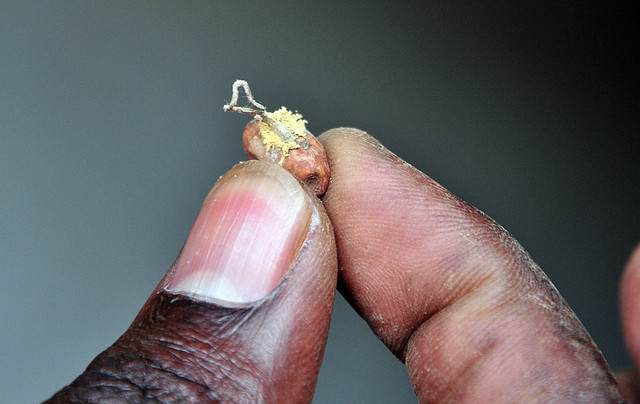Aflatoxins, naturally occurring toxins produced by fungi in grains and other crops, may be linked to childhood stunting and can lead to liver cancer and even death with chronic exposure. More than a public health risk, aflatoxins also pose a significant barrier to international trade, harming poor populations’ economic as well as physical wellbeing.
As the risks associated with aflatoxin contamination have become more widely recognized, many countries have established stricter standards to minimize contamination of food and animal feed. But, for many producers in developing countries, especially smallholders, meeting these standards poses an additional hurdle to their ability to supply commercial markets. In fact, the World Bank estimates that the European Union’s new aflatoxin standards have cost African countries around $670 million annually in lost exports of cereals, dried fruits, and nuts. What’s more, markets in developing countries don’t often reward reduced aflatoxin levels because detecting contamination is prohibitively costly and time-consuming. Poor farmers are unlikely to spend their time and money on improved techniques if they have no economic incentive for doing so.
A new series of IFPRI 2020 Vision Initiative briefs examines how markets can play a significant role in aflatoxin reduction by identifying key points of contamination and providing incentives for reduced aflatoxin levels. “Market incentives are key to making new and existing solutions viable,” says co-editor Laurian Unnevehr of IFPRI. “The challenge is creating the market institutions that will reward smallholders and crop handlers for aflatoxin control.”
Looking at the entire supply chain to identify where and how to best reduce contamination is a crucial first step:
* Brief 6 describes the approach of Mars Incorporated, one of the world’s largest food manufacturers, which has established a “farm-to-fork” quality-management approach including on-farm crop surveys, supplier quality assurance, and in-factory quality testing. Such a comprehensive testing program can identify where in the value chain aflatoxin contamination is more prevalent, helping to prioritize interventions and market rewards for farmers, traders, and processors.
* There is also a need for cost-effective processes to identify and reduce aflatoxin contamination at key value chain entry points. The World Food Programme (WFP) addresses this challenge by providing portable boxes of grain-testing equipment (“Blue Boxes”) that let farmers, traders, processors, and WFP staff test crops at any stage in the supply chain as part of their Purchase for Progress procurement strategy. Not only does this ensure that the food purchased from developing-country farmers is safe for consumption, it also provides a basis for feedback along the entire supply chain, improving aflatoxin control, educating market actors about testing and mitigation techniques, and expanding access to markets with stricter standards – and higher prices.
* TwinTrade, a UK-based fair trade company, takes a similar approach by providing groundnut farmers in Malawi with cheap access to mechanical groundnut shellers. While traditional shelling practices include soaking groundnuts in water to soften the shells, which can lead to increased risk of mold and aflatoxin contamination, the mechanical shellers remove the need to wet the groundnuts, thereby reducing contamination at a key value chain entry point. The program also establishes a bonus scheme in which farmers are financially rewarded for producing groundnuts with low moisture content. This scheme not only provides a direct market incentive for farmers to reduce contamination levels, it also benefits processors and traders by allowing them to reliably identify products that will be acceptable for sale on the international market.
Finally, it is necessary to recognize that, even with enhanced testing and mitigation practices, some aflatoxin contamination will still occur, and producers need an alternative outlet through which to sell contaminated crops to recoup their investments, without risking human or animal health. For groundnut farmers in Malawi, one such outlet is the production of groundnut oil, a key export crop which can be filtered using a simple process to reduce aflatoxins to safe levels.
This creates a safe, high-value product that can increase farmers’ access to global markets, and also reduces the chance of contaminated groundnuts being dumped on less regulated local markets.







